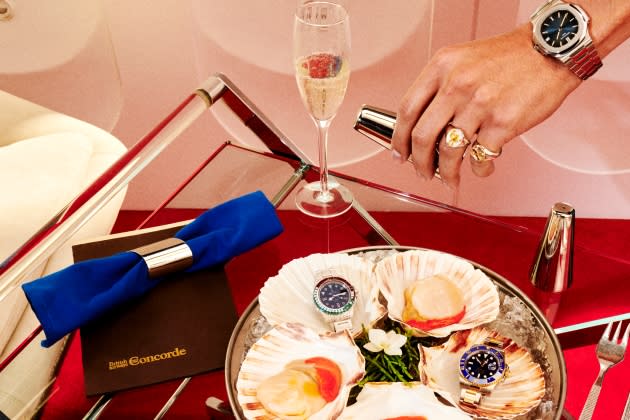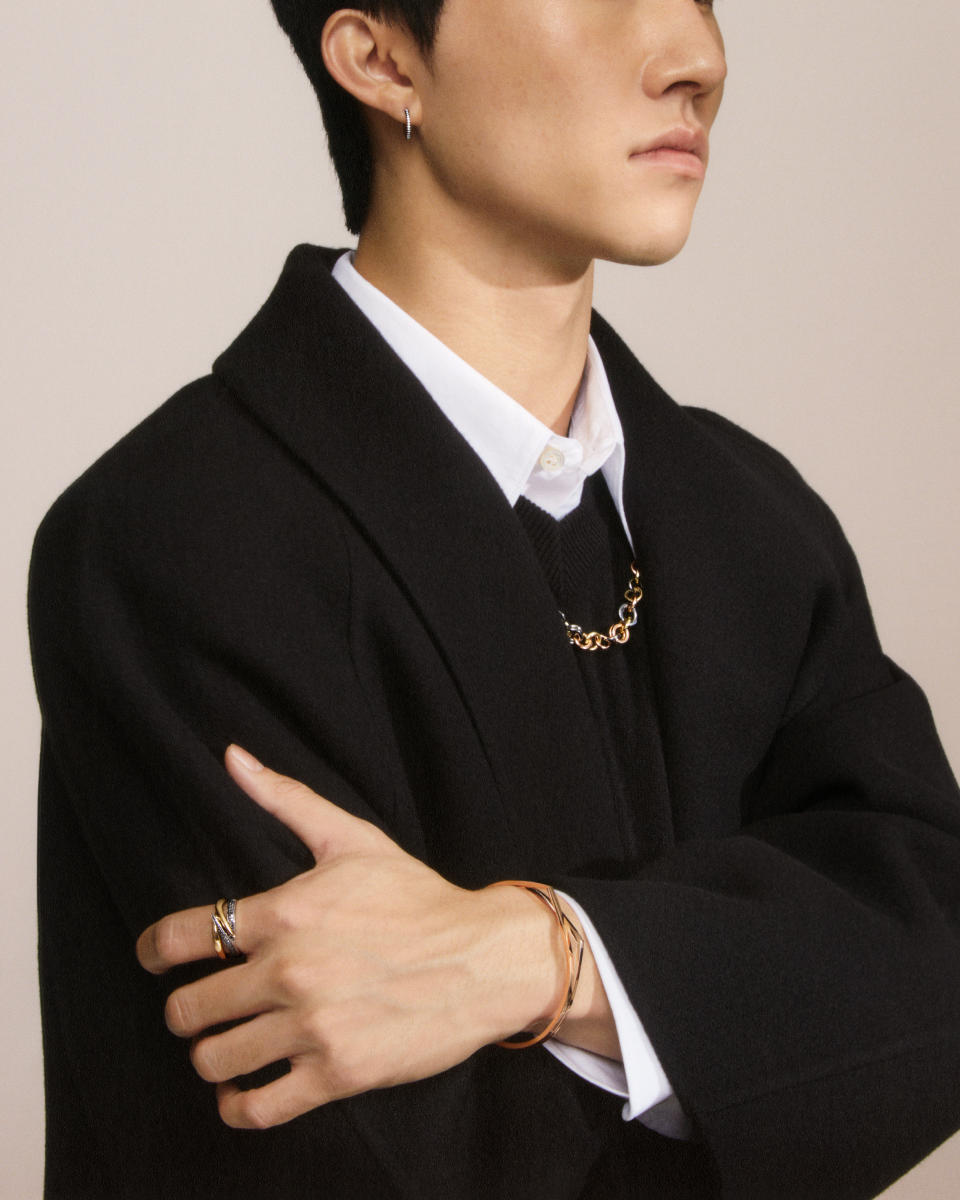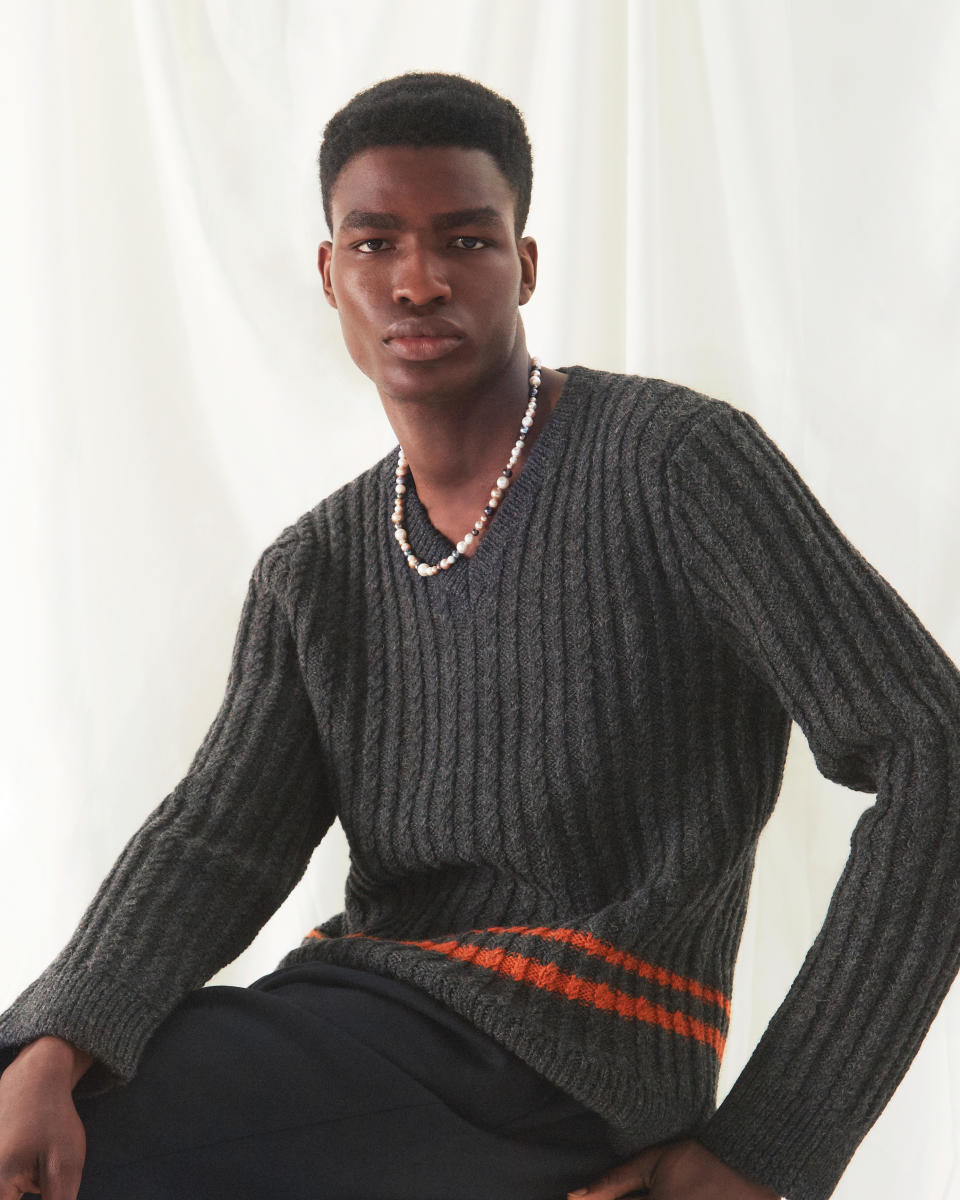Men Are Buying More Fine Jewelry Pieces, Here’s Why
- Oops!Something went wrong.Please try again later.

MILAN — Jewels have always held a special place in defining the standing, power, and attributes of men throughout history. In ancient times and upon the founding of civilizations, they were associated with strength and mysticism, often imbued with magical powers and linked to religious beliefs.
But what is the statement male consumers are now making by tapping into the burgeoning men’s jewelry category?
More from WWD
While pre-pandemic men still tended to shy away from bold pieces and embraced more subdued jewels — think sterling silver rings and chain link necklaces, or tag charms dangling from sober bracelets — almost two years into the COVID-19 health emergency, things have changed.
The pandemic seems to have fostered a new appetite for daring, experimental and personalized pieces, with fine jewelry booming.
According to market research firm Euromonitor International, the men’s jewelry sector is valued at $6.5 billion in 2021, up 17 percent compared to 2020 and almost 4 percent versus 2019. The sector has been growing steadily over the 2015-to-2021 period — save for the pandemic fallout — at a compound annual growth rate of over 3 percent.
While the direct-to-consumer business model has opened the way to affordable brands tapping into the burgeoning men’s market, online retailers contend that fine jewelry is the unexpected booming segment.
Case in point: Mr Porter has increased its men’s offering by 200 percent this year to satisfy the “deeper customer intrigue and engagement on the category,” as Maxim De Turckheim, senior fine watch and jewelry buyer, explained. He attributed the significant uptick to customers who “are choosing to invest in high-quality pieces with craftsmanship at the heart, which will last the test of time.”

Courtesy of Mr Porter
To be sure, the fine jewelry segment has been on a growth path despite the pandemic with 2021 sales reportedly up 7 percent year-over-year to 22 billion euros, according to the 20th edition of the “Luxury Goods Worldwide Market Study” conducted by consulting firm Bain & Co. in collaboration with Italian luxury goods association Altagamma.
Men have been drawing a parallel with the luxury watch segment, traditionally a strong category among male customers with the products often viewed as an investment. Similarly, rare gemstones are growing in demand, as underscored by Min Lee, head of jewelry at Farfetch.
“Male customers are really looking at both metals and minerals and buying diamonds, pearls and gemstones in sterling silver, gold and platinum. It is really nice to see colored gemstones also bought by men at the moment,” she said.
According to Damien Paul, head of men’s wear at Matchesfashion ,“many customers prioritize investment pieces when adding to their wardrobes and jewelry is no different. Whether a piece of jewelry is timeless and discreet or makes a bold statement, men with different tastes and styles are experimenting with it, confident that they will wear it far beyond a season or two.”
He attributed a renewed focused on self-expression to the broader access to sportsmen, musicians and social media stars sporting bold jewelry. This was the case for London-based brand Otiumberg, which has seen its men’s category skyrocket 337 percent in 2020 after Irish actor Paul Mescal was seen wearing the brand’s oval engraved pendant.
It was not an unexpected outcome since the chain necklace Mescal wore in Amazon Prime Video’s hit series “Normal People” spurred a frenzy and dedicated fan Instagram accounts were launched.

Courtesy of Otiumberg
During the past year “there were a lot of male self-gifting purchases and I think this coincided with conversations around men’s jewelry, thanks, in part, to ‘Normal People,'” said Otiumberg’s cofounder Christie Wollenberg. “We also saw our female customers buy into men’s chains which I’m sure was a direct result of this series. Everyone wanted their partners to look a little bit like Paul,” she quipped.
Building on this momentum, the brand expanded its unisex offering and explored personalization to make its chains, engraved pendants, and earrings even more attractive to male customers looking for timeless pieces.
Besides that, retailers agreed that the rise of new notions of masculinity has pushed men to be more experimental and embrace daring pieces, such as pavé Cuban chain link necklaces by Shay; edgy rings, including a rainbow baguette style with diamonds and sapphires by Suzanne Kalan, and David Yurman’s pieces mixing solid 18-karat gold with white gold and diamonds.
“I would certainly say men are shifting toward more unusual, beautifully crafted pieces from talented jewelry designers rather than only focusing on established big brand names,” said Matchesfashion’s Paul, who noted that jewels feeling “individual” are booming.
For instance, at Farfetch there’s a mix of established names and younger designers, with men tapping into Chopard and Boucheron, as well as Joy BC, Foundrae and Shay. “The pieces are bolder, chunkier, and much more statement [making],” said Lee, underscoring how men are keen to support new names.
“I think that post-pandemic people going out, dressing up again and wanting to personalize their looks have benefited the fine jewelry category. We see more statement and one-of-a-kind pieces selling,” she contended.
As such, the men’s jewelry category is seen reaching maturity and gearing up for a new chapter.
The “boundaries between men’s and women’s continues to blur and with this jewelry as a category will continue to evolve,” offered Browns’ assistant buyer of fashion and fine jewelry Yasmin Lane.
The London-based retailer has grown its offering to include 25 new brands, such as conscious jewels from Pyrrha, rock-and-roll pieces from Luis Morais and ‘70s-inspired creations by Hoorsenbuhs. The pandemic, Lane said, “has encouraged men to take more risks, particularly with their accessories, and those who never considered themselves as jewelry wearers previously are really beginning to explore this category.”

Owen Reynolds/Courtesy of Matchesfashion
“As we see a changing in attitude towards masculinity, men have pushed to be bolder in their choice of style and expression and being much more experimental with fine jewelry,” Mr Porter’s De Turckheim added.
“There’s a bigger appetite for anything but plain or traditional as our customers are becoming more adventurous with colors and textures as well as being experimental and less intimidated by new trends such as pearls, beads, enamel, and colorful gemstones,” Lane concurred.
As men buy more jewelry, Farfetch’s Lee said that this “will have a strong impact on the overall fine jewelry industry which has primarily focused on women. I look forward to seeing more unisex and men’s fine jewelry being created and offered, and more men wearing fine jewels in daily life and for special occasions.”
Chris Kyvetos, buying director of men’s wear at Mytheresa, has seen a consistent performance for the e-tailer’s men’s jewelry section, regardless of the pandemic-induced style shifts.
“Our men’s wear direction has always focused on dressing men both pre- and post-lockdowns. Jewelry fits well into this as a staple within the men’s wear wardrobe,” Kyvetos said.
He didn’t seem to acknowledge this as an emerging trend, either. “Fashion doesn’t always recognize generational shifts as what they are, everything seems to be somewhat thrown into a ‘new trend’ lens,” he said.
The Munich-based company has been primarily focusing on mid-fine jewelry and is just starting to embrace hard luxury with the exclusive introduction of Copenhagen brand Elhanati and a deal with bespoke jeweler Duffy already in the pipeline. “Fine jewelry, we are considering more for the future whilst the demand continues to grow for this category,” he said.
According to De Turckheim, the rise in demand will sustain momentum as “men have found fine jewelry as a way to express themselves and are not about to let this go anytime soon.”
Sign up for WWD's Newsletter. For the latest news, follow us on Twitter, Facebook, and Instagram.

